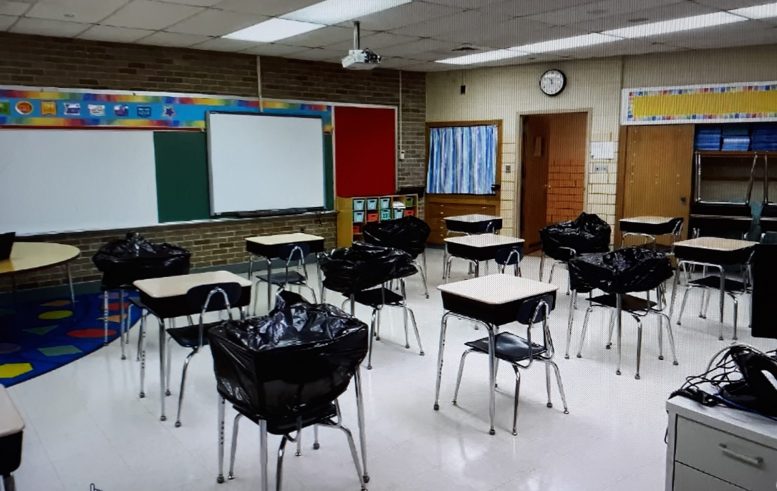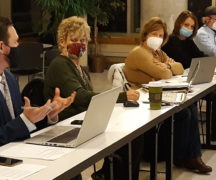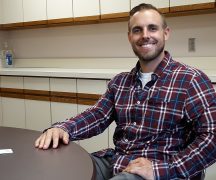By JAN LARSON McLAUGHLIN
BG Independent News
Bowling Green City School students will be headed back to the classroom this fall – at least some of them. There are many unknowns still, but there are some certainties.
First, it appears all school employees and students will be wearing masks all day.
Second, none of the options considered will make all parents happy.
The Bowling Green Board of Education spent two and a half hours Thursday evening learning about the four options considered by the district. Two of the four plans – for full opening of all buildings, and for full on-line learning – were already out of the running.
That leaves the “blended” and the “split schedule” options.
The next meeting of the board will be held July 16, at 5 p.m. Board members are hoping to get input on the two remaining options from parents by then.
“There is no plan that is going to exist that is going to make every person, every parent happy,” Superintendent Francis Scruci said.
But the district’s goal has to be to keep students and staff safe while providing education, he said.
“There is no ‘one size fits all,’” he said, predicting criticism from displeased parents. “To compare districts is very reckless. I cannot recommend anything to the board based on what our neighbors are doing.”
Following are the two options being considered by BG Schools for the fall.
The blended model would provide PK-12 classes, with all buildings open. Groups of students would stay together and with the same teacher throughout school days and groups would not mix. Students will be reminded to remain at least 6 feet apart and to not share objects.
In this blended model, there would be staggered scheduling to accommodate smaller class sizes.
The school district will offer a blended learning environment, in which both face-to-face instruction and online instruction will be provided in a consistent schedule throughout the year.
With the blended model, all students would have face-to-face access to teachers 40% of each week. School buildings would be closed on Mondays for deep cleaning. One group of students would attend school on Tuesdays and Wednesdays, and the other group would attend school on Thursdays and Fridays. The days they are not in school, there would be online learning provided for students.
A downside of this model is that the three of the district’s five schools have no air conditioning, and fans cannot be used according to safety guidelines. So Conneaut Elementary, Kenwood Elementary and the high school would be switched to online learning on days when it is extremely hot.
The split schedule model would provide face-to-face learning for elementary students, and online learning for grades 6-12. Groups of students would stay together and with the same teacher throughout school days and groups would not mix. Again, students would be required to remain at least 6 feet apart and not share objects
The split schedule would require kindergarten through second graders to attend school at Crim Elementary, while third through fifth graders would attend the middle school, which have air conditioning.
Elementary students who remain at home due to parent choice will be provided an online curriculum. A deadline for this option will be set for families.
Students in grades 6-12 will participate in a scheduled online learning environment taught by middle school and high school teachers.
The split schedule model would have elementary students in school four days each week, with the fifth day dedicated to cleaning the buildings. The downsides to this model include the fact that all 6-12 students would only have online learning, and there would be financial costs to moving elementary students to just Crim and the middle school.
Regardless of the plan selected, students will sit at desks 6 feet from anyone else, including the teachers. In some cases, clear desk shields will be installed at tables used by more than one student at a time.
Following are some of the recommendations presented to the board Thursday evening.
Buildings
● The secondary staff workday will be 7:20 a.m.-3 p.m. Elementary staff workday will be 8:15 a.m. – 3:55 p.m.
● Water bottles will be permitted. Water bottle dispensers will be installed replacing traditional water fountains.
● Upon entering the building, students will be required to go directly to their first period class, homeroom, or grade-level classroom. No congregating in groups in the hallways or outside the building will be allowed.
● No visitors will be permitted in the buildings until further notice.
● No volunteers will be allowed until further notice.
● Students will not be permitted to use lockers in the academic areas of the buildings.
● Masks are required for all staff PK-12 and students K-12 in all common areas and during transitions.
● Fans of any kind are prohibited in classrooms.
● Each building will develop its own dismissal plans based on the uniqueness of each building and grade level.
Transportation
● Students will be assigned specific seats on the bus.
● One student per seat on the bus unless family relation.
● On arrival – students will be dismissed one at a time.
● Masks will be required when being transported by bus K-12.
● No field trips until further notice.
● No Fifth Grade Camp for the 2020-21 school year.
Health and Safety
● Parents will be responsible to take student temperatures and assess at home. If a student has a fever or symptoms, he/she must stay home.
● Staff will be responsible to take temperatures and self-assess at home. If a teacher has a fever or shows symptoms, they must stay home.
● All staff PK-12 will be required to wear masks unless for medical reasons, at which time a face shield that extends below the chin is required.
● Students will be required to wear masks in the classroom K-12. If a medical condition exists, students will be required to wear a face shield instead of a mask. Students with disabilities will be considered on an individual basis.
● If a student develops symptoms/fever while at school, they will be placed in the designated isolation room. Parents will be required to pick up their students within 30 minutes.
● Custodians will be sanitizing door handles and other touch points throughout the day in all buildings.
● Recess will be allowed, but children will be required to maintain social distancing.
Classrooms
● Classrooms will be set up to maintain the recommended 6 feet social distancing.
● Mandatory seating assignments will be made in all classrooms.
● Students will be required to wear masks in the classroom K-12.
● Students will be permitted to take bookbags in the classroom.
● No fans for air movement or cooling are permitted in the classroom.
● No exhaust fans can be used in labs.
● Desks and tables will be sanitized at the end of each class period at the secondary level, while sanitizing of desks or tables will occur at lunchtime and before dismissal at the elementary level.
● Teachers will maintain a 6 feet social distance during instructional time.
Food Service
● Breakfasts and lunches will be eaten in the classroom unless buildings can create a schedule for small numbers of students to eat in the cafeteria while maintaining 6 feet social distancing.
● Delivered lunches from outside vendors are prohibited for staff and students.
● Lunches will continue to be provided for children at home, though the details of the program have not been ironed out.
Crim Principal Zeb Kellough said the results of a parent and staff survey helped the district get an idea of concerns from both groups. Nearly 1,300 parents and more than 300 staff responded.
“We felt it was very important we have some type of data to start with,” Kellough said. “We needed to hear from our parents about their comfort level.”
Of the respondents, 14% have children with high risk health conditions, 35% have family members with health concerns, and 25% of parents said they would not send their students back to the classroom this fall.
“Because of this, we have an online option,” Kellough said.
Parents expressed other concerns, such as 85% whose biggest worry was keeping their students interested in school, 63% who were concerned about the emotional health of their child, and 51% who felt they did not have the ability to support their child’s learning at home.
The school district must make a decision on which plan it will take in the fall by July 27, Scruci said. Once the board picks an option, more details will be shared with staff and parents.
“We know we’re going to be criticized. We’re going to recommend what’s best for our students and our families,” Scruci said.
Regardless of which option is selected, the administrative team wants students and staff to wear masks – though the state is not requiring them for elementary students.
“The safest and best thing we can do is have kids wear masks at all times,” Scruci said. “We have to protect everybody.”
Parents can send children with masks, or the district will provide new disposable ones for each day. That could add up to more than 500,000 for the school year, Scruci said.
Chuck Martin, head of maintenance for BG Schools, explained that hand sanitizer dispensers will be outside every classroom, inside classrooms, and in common areas.
“You’re not going to have to hunt to find sanitizer,” he said.
Hand dryers will be shut off in bathrooms, paper dispensers will be added, water bottle refillers will be touchless, and sprayers will be used to disinfect buses. It’s a possibility more custodians will need to be hired if the board goes with the “blended” option.
Board member Tracy Hovest expressed her concerns about students and parents if in-person classes are not offered five days a week.
“We cannot ensure support is there outside the classroom,” she said. “We cannot allow this to fall in the laps of our parents.”
Angie Schaal, executive director of teaching and learning, agreed and said the district is working hard to provide education in a safe manner.
Board President Ginny Stewart asked about the need for the district to support students without necessary technology at home.
“We can’t leave out students who don’t have technology, or the ability for technology,” she said.
Beth Krolak, technology coordinator, said the district will have enough Chromebooks for every student to have one, plus hotspots to use, by the beginning of the school year.
The issue of how schools will function in the fall is an emotional one, with board members expressing their different perspectives.
“As a parent, I want my daughter back in school five days a week,” Hovest said.
Board member Bill Clifford said that science is showing that normal school operations aren’t advisable right now. Stewart agreed.
“Kids are supposed to be in school. But we are also talking about what’s right,” she said.
“It’s human nature for us to seek normal,” board member Jill Carr said. “But normal for us is gone.”





